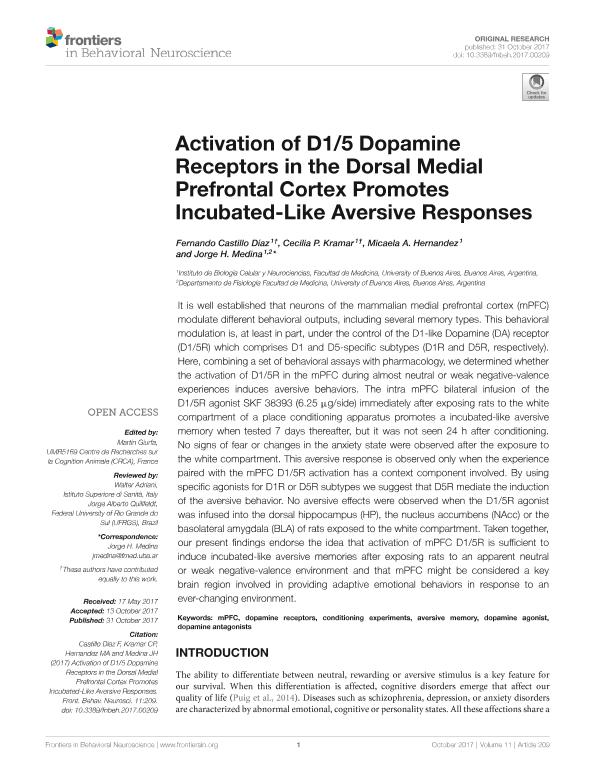Mostrar el registro sencillo del ítem
dc.contributor.author
Castillo Díaz, Fernando

dc.contributor.author
Kramar, Cecilia Paula

dc.contributor.author
Hernandez, Micaela A.
dc.contributor.author
Medina, Jorge Horacio

dc.date.available
2018-06-04T17:21:18Z
dc.date.issued
2017-10
dc.identifier.citation
Castillo Díaz, Fernando; Kramar, Cecilia Paula; Hernandez, Micaela A.; Medina, Jorge Horacio; Activation of D1/5 Dopamine Receptors in the Dorsal Medial Prefrontal Cortex Promotes Incubated-Like Aversive Responses; Frontiers Media S.A.; Frontiers in Behavioral Neuroscience; 11; 10-2017; 1-9
dc.identifier.issn
1662-5153
dc.identifier.uri
http://hdl.handle.net/11336/47153
dc.description.abstract
It is well established that neurons of the mammalian medial prefrontal cortex (mPFC) modulate different behavioral outputs, including several memory types. This behavioral modulation is, at least in part, under the control of the D1-like Dopamine (DA) receptor (D1/5R) which comprises D1 and D5-specific subtypes (D1R and D5R, respectively). Here, combining a set of behavioral assays with pharmacology, we determined whether the activation of D1/5R in the mPFC during almost neutral or weak negative-valence experiences induces aversive behaviors. The intra mPFC bilateral infusion of the D1/5R agonist SKF 38393 (6.25 µg/side) immediately after exposing rats to the white compartment of a place conditioning apparatus promotes a incubated-like aversive memory when tested 7 days thereafter, but it was not seen 24 h after conditioning. No signs of fear or changes in the anxiety state were observed after the exposure to the white compartment. This aversive response is observed only when the experience paired with the mPFC D1/5R activation has a context component involved. By using specific agonists for D1R or D5R subtypes we suggest that D5R mediate the induction of the aversive behavior. No aversive effects were observed when the D1/5R agonist was infused into the dorsal hippocampus (HP), the nucleus accumbens (NAcc) or the basolateral amygdala (BLA) of rats exposed to the white compartment. Taken together, our present findings endorse the idea that activation of mPFC D1/5R is sufficient to induce incubated-like aversive memories after exposing rats to an apparent neutral or weak negative-valence environment and that mPFC might be considered a key brain region involved in providing adaptive emotional behaviors in response to an ever-changing environment.
dc.format
application/pdf
dc.language.iso
eng
dc.publisher
Frontiers Media S.A.
dc.rights
info:eu-repo/semantics/openAccess
dc.rights.uri
https://creativecommons.org/licenses/by-nc-sa/2.5/ar/
dc.subject
Aversive Memory
dc.subject
Conditioning Experiments
dc.subject
Dopamine Agonist
dc.subject
Dopamine Antagonists
dc.subject
Dopamine Receptors
dc.subject
Mpfc
dc.subject.classification
Inmunología

dc.subject.classification
Medicina Básica

dc.subject.classification
CIENCIAS MÉDICAS Y DE LA SALUD

dc.title
Activation of D1/5 Dopamine Receptors in the Dorsal Medial Prefrontal Cortex Promotes Incubated-Like Aversive Responses
dc.type
info:eu-repo/semantics/article
dc.type
info:ar-repo/semantics/artículo
dc.type
info:eu-repo/semantics/publishedVersion
dc.date.updated
2018-06-01T19:26:31Z
dc.journal.volume
11
dc.journal.pagination
1-9
dc.journal.pais
Suiza

dc.journal.ciudad
Lausana
dc.description.fil
Fil: Castillo Díaz, Fernando. Universidad de Buenos Aires. Facultad de Medicina. Instituto de Biología Celular y Neurociencias; Argentina
dc.description.fil
Fil: Kramar, Cecilia Paula. Universidad de Buenos Aires. Facultad de Medicina. Instituto de Biología Celular y Neurociencias; Argentina
dc.description.fil
Fil: Hernandez, Micaela A.. Universidad de Buenos Aires. Facultad de Medicina. Instituto de Biología Celular y Neurociencias; Argentina
dc.description.fil
Fil: Medina, Jorge Horacio. Universidad de Buenos Aires. Facultad de Medicina. Instituto de Biología Celular y Neurociencias; Argentina. Consejo Nacional de Investigaciones Científicas y Técnicas; Argentina
dc.journal.title
Frontiers in Behavioral Neuroscience
dc.relation.alternativeid
info:eu-repo/semantics/altIdentifier/doi/https://dx.doi.org/10.3389/fnbeh.2017.00209
dc.relation.alternativeid
info:eu-repo/semantics/altIdentifier/url/https://www.frontiersin.org/articles/10.3389/fnbeh.2017.00209/full
Archivos asociados
